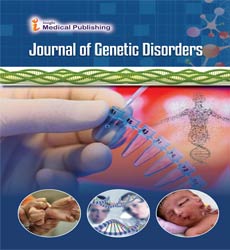Is it Fair to Blame Bacteria alone for Neonatal Sepsis Mortality?
Department of Microbiology, Faculty of Veterinary Medicine, University of Kufa, Iraq
- *Corresponding Author:
- Zina Mohammed Al-Shami
Department of Microbiology
Faculty of Veterinary Medicine
University of Kufa, Iraq
Email: zinam.alshami@uokufa.edu.iq
Received Date: October 18, 2018; Accepted Date: October 23, 2018; Published Date: October 26, 2018
Citation: Al Shami ZM (2018) Is it Fair to Blame Bacteria alone for Neonatal Sepsis Mortality. J genet Disord 2:7.
Copyright: © 2018 Al Shami ZM. This is an open-access article distributed under the terms of the Creative Commons Attribution License, which permits unrestricted use, distribution, and reproduction in any medium, provided the original author and source are credited.
Editorial
Even with the remarkable advances in supportive care and in understanding the causes and pathogenesis of sepsis and its associated immune response, sepsis remains the major cause of neonatal morbidity and mortality, especially among premature infants. The incidence is 1 and 4 cases per 1000 live births for full-term and premature infants respectively, and the mortality rates range from 15% to 50%. 7% of mortality in children under 5 years and 15% in neonates was related to sepsis and meningitis in 2016.
Neonatal sepsis is a life-threatening condition expressed as Apnea, Bradycardia, Decreased temperature or temperature instability, Weak suck and jaundice.
Studies found that, organisms most frequently involved in neonatal sepsis are Group B Streptococci and Escherichia coli, which account for approximately 70% of infections combined. Additional pathogens which account for the remaining cases are Streptococcus pneumoniae, Staphylococcus aureus, Enterococcus spp., Gram-negative enteric bacilli such as Enterobacter spp., Haemophilus influenza.
In fact, Isolation of such pathogens from neonates with sepsis is not enough to consider infection as the main risk factor that causes the neonatal death as stated by some studies. Actually, Sepsis is a complex disease resulting from the interaction of a person’s genotype with environmental factors. Septic neonates have an upregulation and obvious decline of several genes, which involved in innate immunity (IL1R2, ILRN, and SOCS3). In addition, there are genotype specificity that can be associated with a significant increase in risk of developing severe sepsis like Genotypes GG of rs2569190 (the CD14 gene) and AT of rs4073 (the IL8 gene). Genotype AG of rs1800629 (the LTA gene) and genotypes CC and CT of rs1341023 (the BPIgene) were associated with a significantly increased risk of developing Gram-negative sepsis. Truthfully, genetic variability plays a big role in sepsis as well as the risk of having disease due to specific pathogens. Same pathogen isolated in sepsis cases can play a significant role in developing the immune system defenses in health neonates.
So, In order to manage neonatal sepsis, we are in need for a research to develop prevention strategies based on early diagnosis of neonatal genetic disorders as a predisposing factor for the development of different kinds of infections. Future medical research should focus on reducing the application and duration of antibiotics for neonatal sepsis to decrease the emergence and dissemination of resistant bacteria strains. Multidrug resistant pathogens is one of the challenging problems to the effective management among neonatal sepsis. Wise use of antibiotics will aid in reducing drug resistance among resistant pathogens and emerging of new resistant strains. Empirical therapy options should be carefully chosen especially in case of neonatal sepsis caused by Methicillin resistant Staphylococcus aureus (MRSA) strains, one study which conducted in Nigeria encouraged the use of Vancomycin as an empirical therapy in such cases, the overuse of Vancomycin may lead to emerging of the difficult to treat Vancomycin resistant Staphylococcus aureus (VRSA) strains. In addition, empirical use of antibiotic may lead to other complications as in the case of Disseminated intravascular coagulation resulted from the use of Bactericidal antibiotic for treatment of Gram negative bacterial infection leading to liberation of the lipopolysaccharide part of the bacterial cell wall leading to infant death.
So, neonatal sepsis is a multifactorial syndrome that need careful diagnosis and interpretation and the treatment may need more than just antibiotic therapy the use of blood apheresis might be helpful.
Open Access Journals
- Aquaculture & Veterinary Science
- Chemistry & Chemical Sciences
- Clinical Sciences
- Engineering
- General Science
- Genetics & Molecular Biology
- Health Care & Nursing
- Immunology & Microbiology
- Materials Science
- Mathematics & Physics
- Medical Sciences
- Neurology & Psychiatry
- Oncology & Cancer Science
- Pharmaceutical Sciences
